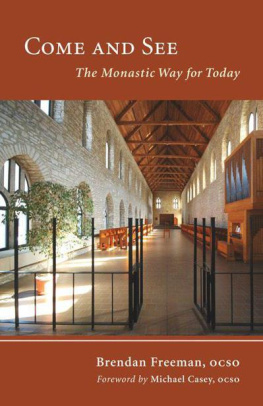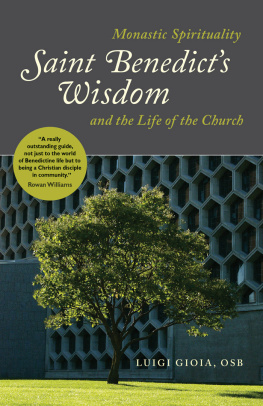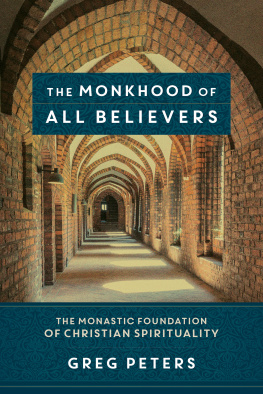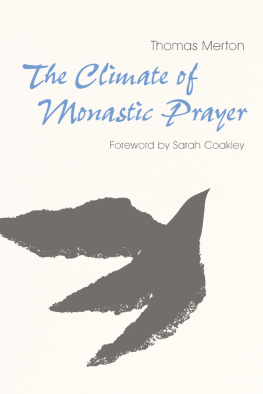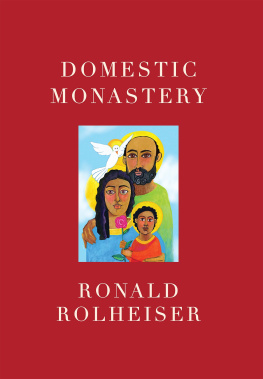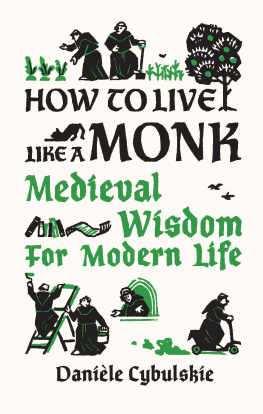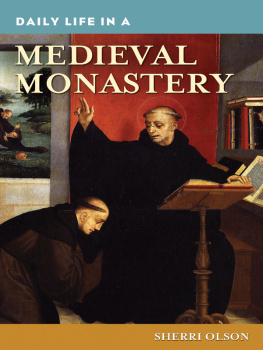MONASTIC WISDOM SERIES: NUMBER TWENTY-TWO
Brendan Freeman, OCSO
Come and See
The Monastic Way for Today
MONASTIC WISDOM SERIES
Patrick Hart, OCSO , General Editor
Advisory Board
Michael Casey, OCSO Terrence Kardong, OSB
Lawrence S. Cunningham Kathleen Norris
Bonnie Thurston Miriam Pollard, OCSO
MW1 Cassian and the Fathers: Initiation into the Monastic Tradition
Thomas Merton, OCSO
MW2 Secret of the Heart: Spiritual Being
Jean-Marie Howe, OCSO
MW3 Inside the Psalms: Reflections for Novices
Maureen F. McCabe, OCSO
MW4 Thomas Merton: Prophet of Renewal
John Eudes Bamberger, OCSO
MW5 Centered on Christ: A Guide to Monastic Profession
Augustine Roberts, OCSO
MW6 Passing from Self to God: A Cistercian Retreat
Robert Thomas, OCSO
MW7 Dom Gabriel Sortais: An Amazing Abbot in Turbulent Times
Guy Oury, OSB
MW8 A Monastic Vision for the 21st Century:
Where Do We Go from Here?
Patrick Hart, OCSO , editor
MW9 Pre-Benedictine Monasticism:
Initiation into the Monastic Tradition 2
Thomas Merton, OCSO
MW10 Charles Dumont Monk-Poet: A Spiritual Biography
Elizabeth Connor, OCSO
MW11 The Way of Humility
Andr Louf, OCSO
MW12 Four Ways of Holiness for the Universal Church:
Drawn from the Monastic Tradition
Francis Kline, OCSO
MW13 An Introduction to Christian Mysticism:
Initiation into the Monastic Tradition 3
Thomas Merton, OCSO
MW14 God Alone: A Spiritual Biography of Blessed Rafael Arniz Barn
Gonzalo Maria Fernndez, OCSO
MW15 Singing for the Kingdom: The Last of the Homilies
Matthew Kelty, OCSO
MW16 Partnership with Christ: A Cistercian Retreat
Eugene Boylan, OCSO
MW17 Survival or Prophecy?
The Correspondence of Jean Leclercq and Thomas Merton
Patrick Hart, OCSO , editor
MW18 Light for My Path: Spiritual Accompaniment
Bernardo Olivera, OCSO
MW19 The Rule of Saint Benedict: Initiation into the Monastic Tradition 4
Thomas Merton, OCSO
MW20 Inside the School of Charity: Lessons from the Monastery
Trisha Day
MW21 Words for the Journey: A Monastic Vocabulary
Edith Scholl, OCSO
MONASTIC WISDOM SERIES: NUMBER TWENTY-TWO
Come and See
The Monastic Way for Today
by
Brendan Freeman, OCSO
Foreword by
Michael Casey, OCSO

Cistercian Publications
www.cistercianpublications.org
LITURGICAL PRESS
Collegeville, Minnesota
www.litpress.org
A Cistercian Publications title published by Liturgical Press
Cistercian Publications
Editorial Offices
Abbey of Gethsemani
3642 Monks Road
Trappist, Kentucky 40051
www.cistercianpublications.org
2010 by Order of Saint Benedict, Collegeville, Minnesota. All rights reserved. No part of this book may be reproduced in any form, by print, microfilm, microfiche, mechanical recording, photocopying, translation, or by any other means, known or yet unknown, for any purpose except brief quotations in reviews, without the previous written permission of Liturgical Press, Saint Johns Abbey, PO Box 7500, Collegeville, Minnesota 56321-7500. Printed in the United States of America.

Library of Congress Cataloging-in-Publication Data
Freeman, Brendan.
Come and see : the monastic way for today / by Brendan Freeman; foreword by Michael Casey.
p. cm. (Monastic wisdom series; no. 22)
ISBN 978-0-87907-022-9 ISBN 978-0-87907-954-3 (e-book)
1. Monastic and religious lifeCongresses. 2. CisterciansSpiritual lifeCongresses. 3. Benedict, Saint, Abbot of Monte Cassino.
RegulaCongresses. I. Title. II. Series. BX2435.F735 2010
255'.12dc2215 2009045359
CONTENTS
by Michael Casey, OCSO
FOREWORD
St. Benedict describes the functioning of the abbots authority in a monastery with three verbs: docere, constituere, iubere (RB 2:4). He is to teach, to establish policy, and to give orders. This is a view of authority that is far more comprehensive than what is commonly held today. More often than not we think of authority merely in terms of giving instructions and policing their observance. For St. Benedict, however, the giving of necessary commands is only the visible part of the iceberg. Before arriving at the point of issuing instructions, the abbot is expected first of all to create a climate of meaning in the monastery, patiently inculcating the beliefs and values according to which monastic life makes sense. This is his task of teaching. The practical task of establishing policy follows. The beliefs and values variously communicated by word and example must be incarnated in structures which bring about a culture that facilitates their observance. It is within the context of a shared philosophy of life that orders are given and needful corrections made.
To an outsider a well-ordered monastery seems to function like a military organization: a defined command structure, conformity and uniformity in action, and an insistence on absolute and immediate obedience. The comparison, however, is deceptive. The perfect monastery, if there were one, would be a community that virtually runs itself without the necessity for multiplying overt interventions of authority. A group of persons who have internalized the essential beliefs and values and are safeguarded by suitable structures will not need close or constant supervision but merely organizational adjustments to suit changing circumstances. Even for less-than-perfect communities St. Benedicts system works well. He builds into his prescriptions a degree of flexibility which enables accommodation to be made for individual weaknesses, foibles, and particular talents. And there is provision made to bring back into the fold the wandering and even the recalcitrant. Micromanagement was never part of Benedicts plan. In modern terms, the abbots primary task is leadership; the bulk of managerial functions can be diverted to deans and other officials.
The foundation of this low-intervention approach to the exercise of authority is the abbatial obligation of teaching. An abbot speaking to his monks in the chapter room is not engaging in academic or intellectual discourse. It is to be hoped that there is a sound basis in theology and exegesis but, at this time and in this place, his objective goes beyond the level of the cognitive. His aim is to hold up a mirror before the eyes of his monks so that they may become more fully aware of what they already believe and cherish, and more conscious of the call to incarnate these principles in behavior. The abbot addresses his remarks especially to their hearts and their consciences, reminding them of who they are, who they are called to become, and by what means they can fulfill the purpose for which they left everything to take up life in the monastery.
The abbots teaching may be considered as ongoing and corporate spiritual formation. If it is well done, when the community comes together to give their counsel on important practical matters (RB 3:1), the options expressed will all fall within the limits of near consensus on the key values by which the community lives. Policy can be established which, although not immutable, endures and is transmitted from one generation of monks to the next. It is within the context of fundamental monastic principles that appointments are made and the management of daily affairs takes place. Likewise, the communal acceptance of the essential components of monastic conversatio provides a basis by which errant brethren can be invited to rejoin community practice. This is what St. Benedict terms correctio , bringing the wanderer back to the common path, as distinct from correptio , rebuking and punishing the deviant to safeguard the common good.
Next page
